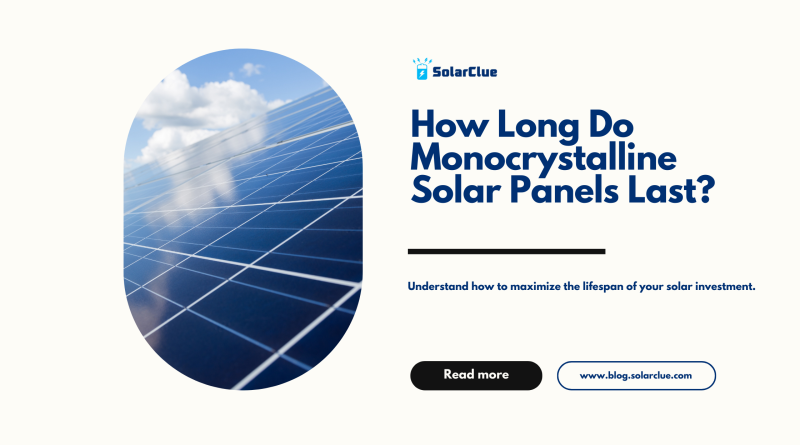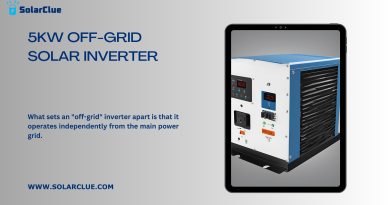How Long Do Monocrystalline Solar Panels Last?
Monocrystalline solar panels are known for their high efficiency and durability, making them a popular choice for both residential and commercial installations. However, like any technology, they have a finite lifespan. This guide explores the factors that influence the longevity of monocrystalline solar panels, from environmental conditions to maintenance practices. We’ll also discuss the concept of degradation, warranties, and insurance coverage, helping you understand how to maximize the lifespan of your solar investment.
Table of Contents
- 1 The Lifespan of Monocrystalline Solar Panels
- 1.1 Factors Affecting Solar Panel Durability
- 1.2 Environmental Factors and Their Impact
- 1.3 Proper Installation and Maintenance for Longer Lifespan
- 1.4 Solar Panel Degradation and Its Effects
- 1.5 Warranties and Insurance Coverage
- 1.6 Factors Influencing the Lifespan of Monocrystalline Solar Panels
- 1.7 Conclusion
- 1.8 FAQ Section
The Lifespan of Monocrystalline Solar Panels
Expected Lifespan:
- Typical Range: Monocrystalline solar panels typically last between 25 to 30 years. However, they can continue to produce electricity beyond this period, albeit at a reduced efficiency.
- Long-Term Performance: Many panels still operate at around 80% efficiency even after 25 years.
Factors Affecting Solar Panel Durability
Panel Quality:
- Manufacturing Standards: Panels from reputable manufacturers with stringent quality control are likely to last longer.
- Material Quality: High-quality materials used in the construction of the panels contribute to their durability.
Installation:
- Professional Installation: Proper installation by certified professionals ensures that panels are securely mounted and positioned for optimal performance, reducing the risk of damage over time.
Maintenance:
- Regular Cleaning: Dust, dirt, and debris can accumulate on the panels, reducing their efficiency. Regular cleaning helps maintain optimal performance.
- Inspection: Regular inspections can identify potential issues, such as loose connections or damage, before they impact the panel’s performance.
Environmental Factors and Their Impact
Weather Conditions:
- UV Exposure: Prolonged exposure to intense sunlight can accelerate the degradation of the solar cells.
- Temperature Fluctuations: Extreme temperature changes can cause thermal expansion and contraction, potentially leading to micro-cracks in the panels.
- Snow and Ice: Heavy snow and ice accumulation can put physical stress on the panels, leading to potential damage if not managed properly.
Geographic Location:
- Coastal Areas: Saltwater corrosion can affect the metal components of the panels, potentially reducing their lifespan if not adequately protected.
- High Wind Areas: High winds can stress the mounting system and increase the risk of physical damage.
Proper Installation and Maintenance for Longer Lifespan
Installation Best Practices:
- Correct Orientation and Tilt: Panels should be installed at the optimal angle and orientation to maximize sunlight exposure and minimize wear.
- Secure Mounting: Ensuring that panels are securely mounted prevents damage from strong winds and other environmental factors.
Maintenance Tips:
- Cleaning: Use non-abrasive materials to clean panels and remove dust and debris.
- Regular Checks: Inspect panels regularly for any signs of damage, such as cracks, discoloration, or loose connections.
Solar Panel Degradation and Its Effects
Understanding Degradation:
- Degradation Rate: Monocrystalline panels typically degrade at a rate of about 0.5% to 1% per year. This means that after 25 years, a panel might operate at 75-88% of its original capacity.
- Factors Influencing Degradation: UV exposure, temperature, and mechanical stress are primary factors that contribute to the degradation of solar panels.
Impact on Performance:
- Long-Term Efficiency: Degradation reduces the amount of electricity the panels can generate over time, but they still produce significant power even after decades.
Warranties and Insurance Coverage
Manufacturer Warranties:
- Performance Warranty: Most manufacturers offer a 25-year performance warranty, guaranteeing that the panels will produce a certain percentage of their original output after 25 years (typically 80-85%).
- Product Warranty: A typical product warranty lasts 10-12 years and covers defects in materials and workmanship.
Insurance Coverage:
- Homeowner’s Insurance: Solar panels are often covered under standard homeowner’s insurance policies, but it’s essential to check with your provider.
- Specialized Solar Insurance: Additional insurance policies specifically for solar installations can cover damage from extreme weather, theft, and other risks not covered by standard policies.
Factors Influencing the Lifespan of Monocrystalline Solar Panels
| Factor | Impact on Lifespan | Explanation |
|---|---|---|
| Panel Quality | Higher quality = Longer lifespan | Panels from reputable manufacturers with high-quality materials last longer |
| Installation | Proper installation = Reduced risk of damage | Certified installation ensures secure mounting and optimal performance |
| Maintenance | Regular maintenance = Sustained efficiency | Regular cleaning and inspections prevent buildup and damage |
| Environmental Conditions | Harsh conditions = Potentially shorter lifespan | UV exposure, temperature fluctuations, and coastal conditions can accelerate degradation |
| Geographic Location | Specific locations = Higher risk of environmental impact | Coastal and high-wind areas may require additional protection |
| Degradation Rate | Lower degradation = Longer useful life | Panels with lower degradation rates maintain higher efficiency over time |
Conclusion
Understanding the lifespan of monocrystalline solar panels and the factors that influence their durability is crucial for maximizing the return on your solar investment. By choosing high-quality panels, ensuring proper installation, and performing regular maintenance, you can significantly extend the life of your solar energy system. This comprehensive guide provides the knowledge you need to protect your investment and ensure your solar panels perform efficiently for decades to come.
Here at SolarClue®, we offer a smart, practical, and “beautiful” solution. You will be answered for all the questions related to Solar.
We provide all kinds of brands that are the Best Solar panels in India.
If you are the one who is planning for the solar power system. Don’t hesitate to contact our team!
Looking forward to empowering you with solar energy, just like hundreds of our other clients!
FAQ Section
1. How long do monocrystalline solar panels typically last?
Monocrystalline solar panels typically last between 25 to 30 years, but they can continue to produce electricity beyond this period at reduced efficiency.
2. What factors can shorten the lifespan of solar panels?
Factors like poor installation, lack of maintenance, harsh weather conditions, and environmental exposure (e.g., UV radiation, temperature fluctuations) can shorten the lifespan of solar panels.
3. What is solar panel degradation, and how does it affect performance?
Solar panel degradation is the gradual loss of efficiency over time, typically around 0.5% to 1% per year. This reduces the amount of electricity the panels generate but does not stop them from producing power.
4. What kind of warranties do manufacturers offer for monocrystalline solar panels?
Manufacturers usually offer a 25-year performance warranty, ensuring the panels will produce a certain percentage of their original output (usually 80-85%) after 25 years. Product warranties typically cover defects for 10-12 years.
5. Is insurance necessary for solar panels, and what does it cover?
Yes, insurance is advisable. Solar panels are often covered under standard homeowner’s insurance, but specialized solar insurance can provide additional coverage for risks like extreme weather or theft.




